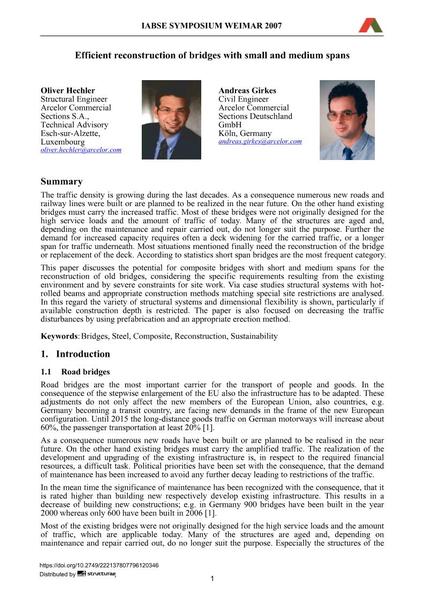Efficient reconstruction of bridges with small and medium spans

|
|
|||||||||||
Détails bibliographiques
| Auteur(s): |
Oliver Hechler
Andreas Girkes |
||||
|---|---|---|---|---|---|
| Médium: | papier de conférence | ||||
| Langue(s): | anglais | ||||
| Conférence: | IABSE Symposium: Improving Infrastructure Worldwide, Weimar, Germany, 19-21 September 2007 | ||||
| Publié dans: | IABSE Symposium Weimar 2007 | ||||
|
|||||
| Page(s): | 218-219 | ||||
| Nombre total de pages (du PDF): | 8 | ||||
| Année: | 2007 | ||||
| DOI: | 10.2749/222137807796120346 | ||||
| Abstrait: |
The traffic density is growing during the last decades. As a consequence numerous new roads and railway lines were built or are planned to be realized in the near future. On the other hand existing bridges must carry the increased traffic. Most of these bridges were not originally designed for the high service loads and the amount of traffic of today. Many of the structures are aged and, depending on the maintenance and repair carried out, do not longer suit the purpose. Further the demand for increased capacity requires often a deck widening for the carried traffic, or a longer span for traffic underneath. Most situations mentioned finally need the reconstruction of the bridge or replacement of the deck. According to statistics short span bridges are the most frequent category. This paper discusses the potential for composite bridges with short and medium spans for the reconstruction of old bridges, considering the specific requirements resulting from the existing environment and by severe constraints for site work. Via case studies structural systems with hotrolled beams and appropriate construction methods matching special site restrictions are analysed. In this regard the variety of structural systems and dimensional flexibility is shown, particularly if available construction depth is restricted. The paper is also focused on decreasing the traffic disturbances by using prefabrication and an appropriate erection method. |
||||
| Mots-clé: |
acier ponts durabilité
|
||||
